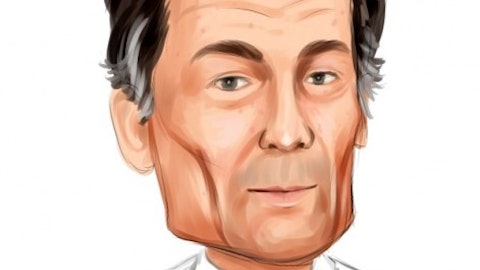CME Group Inc. (NASDAQ:CME) Q4 2023 Earnings Call Transcript February 14, 2024
CME Group Inc. beats earnings expectations. Reported EPS is $2.37, expectations were $2.27. CME Group Inc. isn’t one of the 30 most popular stocks among hedge funds at the end of the third quarter (see the details here).
Operator: Greetings, and welcome to the CME Group Fourth Quarter and Year End 2023 Earnings Call. During the presentation, all participants will be in a listen-only mode. Afterwards, we will conduct a question-and-answer session. [Operator Instructions] I would now like to turn the conference over to Adam Minick. Please go ahead.
Adam Minick: Good morning, and I hope you are all doing well today. We released our executive commentary earlier today, which provides extensive details on the fourth quarter and full year of 2023 which we will be discussing on this call. I will start with the safe harbor language, then I’ll turn it over to Terry. Statements made on this call and in the other reference documents on our website that are not historical facts are forward-looking statements. These statements are not guarantees of future performance. They involve risks, uncertainties and assumptions that are difficult to predict. Therefore, actual outcomes and results may differ materially from what is expressed or implied in any statement. Detailed information about factors that may affect our performance can be found in the filings with the SEC, which are on our website.
Lastly, on the final page of the earnings release, you will see a reconciliation between GAAP and non-GAAP measures. With that, I’ll turn the call over to Terry.
Terry Duffy: Thank you, Adam. And as Adam said, thank you all for joining us this morning. I’m going start by giving a little color on the broader environment. Following that, Lynne will provide an overview of our financial results and our 2024 guidance. In addition to Lynne, we have other members of our management team here to answer questions after the prepared remarks. 2023 was the best year in CME Group’s history with a record average daily volume of 24.4 million contracts, up 5% from 2022. This growth was led by records in both agriculture and interest rate products, which for the year were up 17% and 16%, respectively. Options average daily volume across all asset classes also set a record with ADV of 5.1 million contracts, up 23% versus last year.
Lastly, our non-US average daily volume increased to a record 6.8 million contracts. Last year, I referred to 2023 as a new age of uncertainty. And that uncertainty extended throughout the year. We experienced continued inflation, rising cost of capital, increasing geopolitical tensions and shifting perceptions around the Fed’s interest rate policy. All of these factors contributed to our customers’ growing need for risk management, capital efficiencies and demand for our products. Following the very strong performance of our business in 2022 and 2023, we have seen the speculation that our interest rate business could face headwinds based on the expectation that the Fed will start to lower interest rates this year. In my 40-plus years in the industry, I’ve observed that regardless of whether rates are going up or down, our volumes are typically higher during periods when the change of rates is uncertain as is the case today.
I’ve never seen such a disparity in opinions on what the Fed may or may not do, and I believe that is a tailwind for CME Group and our rates products. I mentioned earlier that our interest rate volume was up 16% in 2023 with four Fed rate hikes during the first half of the year, building off record volume levels of 2022. In contrast to the view that a rising rate environment is optimal for our interest rate complex, our volume actually grew and accelerated since the Fed stopped raising rates in July of last year. In the six months from August of ‘23 through January of ‘24, our rates volume is up 24% year-over-year. I would also like to comment on the dynamics in the crude oil marketplace. Following the Russian/Ukraine war and other geopolitical factors that influenced the price of energy, WTI or West Texas Intermediate has become even more relevant to our customers in Europe and Asia and cemented its position as a primary reference price for crude oil globally.

As the primary market for WTI trading, we continue to generate growth and expanded end user client participation through developing and investing in new contracts such as CME Group’s Argus Gulf Coast contract. In a very short period of time, these contracts have generated significant commercial participation with current open interest over 500,000 contracts. As indicated by the open interest, it’s clear that the commercial participants prefer CME Group’s Argus Gulf Coast contract. We continue to remain focused on the growth of these contracts along with creating capital and technological efficiencies in the entire suite of CME Group’s energy complex. This anchors CME Group as the global leader in West Texas Intermediate. Moving into 2024, we continue to see a wide range of views as it relates to the health of the global economy, whether it’s inflation, unemployment or monetary policy.
Also, there are ongoing geopolitical tensions and supply chain disruptions continuing in certain parts of the world. Additionally, we’re approaching political elections in over 60 countries this year. The uncertainty of those elections and the policies that could come from that are basically unknown to all, which only leads to market participants continue to manage risk. All that being said, 2024 is still very much the age of uncertainty and our products remain critical risk management tools for our clients. We have seen this reflected in our strong start to 2024, where we delivered our highest January average daily volume in our history of 25.2 million, which is up 16% relative to last year. With that being said, I’m going to turn the call over to Lynne and we look forward to taking your questions.
Lynne Fitzpatrick: Thanks, Terry. In addition to the volume records Terry discussed, we delivered record financial results in 2023. Our revenue of $5.6 billion grew 11% compared to 2022. Our annual adjusted expenses, excluding license fees, were approximately $1.526 billion including $56 million related to our cloud migration. In aggregate, our adjusted operating expenses were $9 million below our annual guidance. Our adjusted operating margins for the year expanded to 66.9%, up over 200 basis points from 2022. We delivered $3.4 billion in adjusted net income, resulting in 17% earnings per share growth for the year. During the fourth quarter, CME Group generated more than $1.4 billion in revenue, a 19% increase from Q4 2022 with average daily volume up 17%.
Market data revenue grew 9% from last year to $167 million. Expenses were very carefully managed and on an adjusted basis, were $490 million for the quarter and $393 million, excluding license fees and $16 million in cloud migration costs. CME Group had an adjusted effective tax rate of 21.7%, which resulted in adjusted net income of $865 million. Our adjusted EPS was $2.37, up 23% from the fourth quarter last year, and represented our tenth consecutive quarter of double digits earnings growth. Capital expenditures for the fourth quarter were approximately $23 million and cash at the end of the year was $3.1 billion. CME Group declared over $3.5 billion of dividends during 2023, including the annual variable dividend of $1.9 billion which was paid in January.
Turning to 2024 guidance, we expect total adjusted operating expenses, excluding license fees but including cloud migration expenses, to be approximately $1.585 billion. Total capital expenditures net of leasehold improvement allowances are expected to be approximately $85 million, and the adjusted effective tax rate should come in between 23% and 24%. Finally, in November, we announced transaction fee adjustments, which became effective February 1st. Assuming similar trading patterns as 2023, the fee adjustments would increase futures and options transaction revenue approximately 1.5% to 2%. Taken in aggregate with the fee changes for market data and non-cash collateral which took effect January 1st, the fee adjustments would increase total revenue by approximately 2.5% to 3% on similar activity to 2023.
In summary, we are very proud of the results we were able to deliver as a firm this year, driving 11% revenue growth and 17% adjusted earnings growth from our previous record year of 2022. We’d now like to open up the call for your questions. Thank you.
Operator: [Operator Instructions] Our first question is coming from the line of Dan Fannon with Jefferies. Please go ahead.
See also 20 Fastest Growing Technology Companies in the US and 20 Most Valuable Latin American Companies.
Q&A Session
Follow Cme Group Inc. (NASDAQ:CME)
Follow Cme Group Inc. (NASDAQ:CME)
Dan Fannon: Thanks. Good morning. Maybe, Lynne, just to start on expenses, can you talk about what the areas are for investment in 2024, and how that might be different than what we saw last where dollars went last year? And then also just on the Google partnership, can you update us on the progress there and maybe what you are expecting in terms of contribution as we think about 2024 and 2025 from that relationship?
Lynne Fitzpatrick: Okay, sure. I’ll start on the investment piece. So if you look at the guidance, we are expecting expenses to increase by $60 million year-over-year. That is inclusive of the migration spend. So of that $60 million, about $15 million is an increase in the migration expense. As a reminder, we do expect to have incremental migration expenses this year and next year before we get to cash breakeven and ultimately cash flow positive. The remaining $45 million in increase is related to core expense growth and that’s in the 3% range, very similar to what we’ve seen historically. In terms of Google, I’ll let some of my…
Terry Duffy: Dan, Sunil and Julie will.
Sunil Cutinho: In terms of progress on Google migration, we intend on making substantial progress with migrating, clearing, business information systems and market regulatory systems to the cloud platform. Some of these regulated workloads are of course subject to have no objection approval from regulators, but we intend on making significant progress even on the data side. I’ll now hand over to my colleague, Julie Winkler, who will talk about data and data product.
Julie Winkler: Thanks for the question, Dan. On the client side with Google, we’ve really been focused on areas that we believe are going to enhance our clients’ abilities to really engage in our market and utilize these offerings. The technology with Google Cloud is something that we’re able to leverage. And so our — we’ve been really focused on where we can enhance our data service business. Things like performing the trade execution analytics that we’ve talked about, which is something very unique in terms of our ability to use proprietary data and benchmarking. And we expect to be rolling that out here in 2024. And also a lot of interest from our clients around supporting them to help them better manage their risk. And so looking at how we do that both with data and analytics that we are providing with them.
So we’re on track. We’ve continued to roll out a number of new data services products throughout the year. And as Sunil pointed out, the speed and velocity at which we’re able to deliver has certainly increased now that our core data is in the cloud.
Dan Fannon: Great. Thank you.
Terry Duffy: Thanks, Dan.
Adam Minick: Thank you.
Operator: Our next question is coming from the line of Alex Kramm with UBS. Please go ahead.
Alex Kramm: Yes. Hey, good morning, everyone. Just wanted to come back to the pricing comments you made at the end of your prepared remarks there. I think 1.5% to 2% on the future side. I think that’s kind of back to pre-inflation or high inflation environment, maybe even on the lower side. So can you maybe just talk about how you thought about the price increase this year? Seems like inflation is still somewhat elevated, but then obviously curious if — to what degree client feedback, competitive dynamics are impacting that, if at all? Thank you.
Lynne Fitzpatrick: Sure, Alex. Thanks. I think we look at it in several pieces. One is the clearing and transaction fee, which did increase in the 1.5% to 2% range, but keep in mind, we do think about the different levers of pricing and how they impact different parts of our customer base. So we did increase the collateral fees this year, going from 7 basis points to 10 basis points, and we did increase the market data fees as well. So in aggregate, the total fee change will result in about 2.5% to 3% in total increase in revenue. We want to make sure we’re taking that balanced approach because different fee changes, like the transaction fees will impact certain segments, whereas collateral fees will impact different segments. We’re always looking to balance that impact and make sure we’re not overly burdening one part of our customer base.
Alex Kramm: Fair enough. Thank you.
Terry Duffy: Thanks, Alex.
Operator: Our next question is coming from the line of Owen Lau with Oppenheimer. Please go ahead.
Owen Lau: Good morning, and thank you for taking my question. So CME and DTCC just launched the enhanced cross-moduling arrangement. Could you please talk about the initial feedback from your clients, and please remind us the implication to your clients and to CME longer term about this initiative? Thanks a lot.
Terry Duffy: Thanks, Owen. I’m going to turn it to my colleague, Suzanne Sprague, the President of our Clearinghouse and heads up our Clearing and Risk, and she can give you some fairly good color as it relates to the DTCC arrangement.
Suzanne Sprague: Yeah, thanks, Terry, and thanks for the question. Although it is early days of the program since the launch just a few weeks ago, we do have eight clearing members that are live with the program, and some portfolios are already seeing consistent savings of 75% to 80%. So we’re happy with the uptake of the program that we’ve seen so far, although it is early days and we continue engaging with those clearing members to increase the onboarding and the efficiencies that they’re able to achieve through their portfolio savings.
Terry Duffy: And Owen, I think just to add to what Suzanne said, as you know, and others on the line know, over the last year or so, our former colleague that headed up their business, Sean Tully, talked about the efficiencies that would go along with getting us into the offsets with DTCC and in the ranges of anywhere from 40% to 80%. And so Suzanne’s numbers of 75% to 80% are on the high end of what we were originally looking for. So this is a very exciting opportunity for us and more importantly, our client base.
Owen Lau: Very helpful. Thanks a lot.
Terry Duffy: Thank you.
Operator: Our next question is coming from the line of Ken Worthington with J.P. Morgan. Please go ahead.
Ken Worthington: Hi, good morning, and thanks for taking the question. I wanted to dig further into your comments, Terry, on energy and market share and sort of business shifts in that market. You call that Argus as sort of a preferred crude contract. I was hoping to get more color on crude more broadly and also what you’re seeing in gas. So for crude, what are you seeing in terms of share and participation? And to what degree is the addition of Midland to the Brent marker altering behavior? And in natural gas, it seems like options in globalization seem to be the story here. Was hoping you could provide some perspective.
Terry Duffy: Sure, Ken. There’s a little bit to unpack there. So I’m going to take part of it. I’m going to take some of it and ask Mr. Sammann to comment on the gas and the back part of your energy question. But when we talk about our Argus contract, we’re talking about a contract that is based out of the same region that there’s a competitive contract trading as well. We’re just pointing out that our contract is very much attracted by the large commercial participation with the reflection of over 0.5 million open positions compared to others in the same region that have the same risk characterizations as ours. So we think that’s a very much a net positive for us. As far as market share goes, Ken, being around a long time, like unfortunately I said earlier, when you look at markets that are in a 10 month range of less than $10 a barrel in energy, you will see shifts in behavior shifts of percentage points here or there going back and forth, depending on what’s going on, on any given day.
So that doesn’t surprise us. We’ve seen that historically since we acquired the New York Mercantile Exchange. So, those are things I’m not surprised by in this low-vol environment. So, that being said, let me — if that gives you an understanding of what we’re talking about in the Midland area and also about the percent changes going back and forth in low-vol times, and then I’ll ask Derek to comment on the gas and the options as well, I think was the other part of the question.
Derek Sammann: Yeah, thank you. Let me take a step back a little bit, and I think it’s important to note that our WTI franchise is bigger than just our CL contract. So, I want to point out a couple of ways that we continue to invest in, innovate, and grow our overall WTI portfolio in this range-bound and quiet volatility market. Terry mentioned one of those, which is the crude grades contracts, and that’s a growth story with a significant participation from the commercial end user base, and that’s reflective of WTI now being part of the Brent assessment, and that just means it further cements WTI as a global benchmark. Secondly, we continue to expand our WTI options franchise. We added — expanded weekly expirations Mondays and Wednesdays.
That’s driving 35% growth in our crude and refined options business so far this year. Third, we continue to invest in our micro contracts. We have ADV over 100,000 contracts, 50,000 unique traders in that market, and the products overall have been a great entry point for new clients acquisition. A lot of these customers have never traded an energy contract before, so we continue to onboard new clients through that. So, all these products in our broader WTI portfolio reinforce WTI as the main benchmark globally, and it contributes strongly to the overall energy franchise growth we’ve seen into 2024, with overall energy up 21% and our options growth particularly up 87%.
Terry Duffy: Yes.
Derek Sammann: Pivoting over to natural gas, Ken, you’re right. It’s a significant story, and I think when you look at the fact that the US has now become a significant, both producer and exporter of natural gas, that really has positioned Henry Hub as a central benchmark globally for LNG as natural gas continues to be consumed globally. When you look at that business over the course of last year, you’ve seen significant growth. Globalization, you’re absolutely right, when you continue to see the growth that we’ve seen in 2023, we saw our European nat gas volumes up almost 50%, and we’re seeing that business up almost 100% so far in the first six to seven weeks of 2024. When you look at both the commercial participation, natural gas was up 30% with our commercial participants last year.



